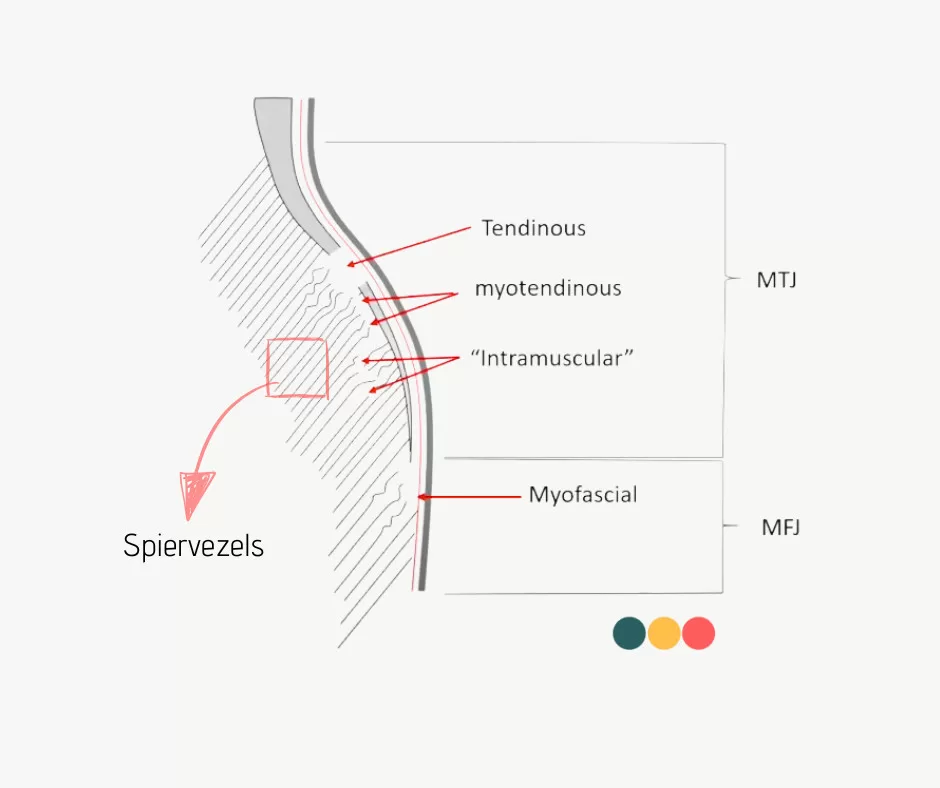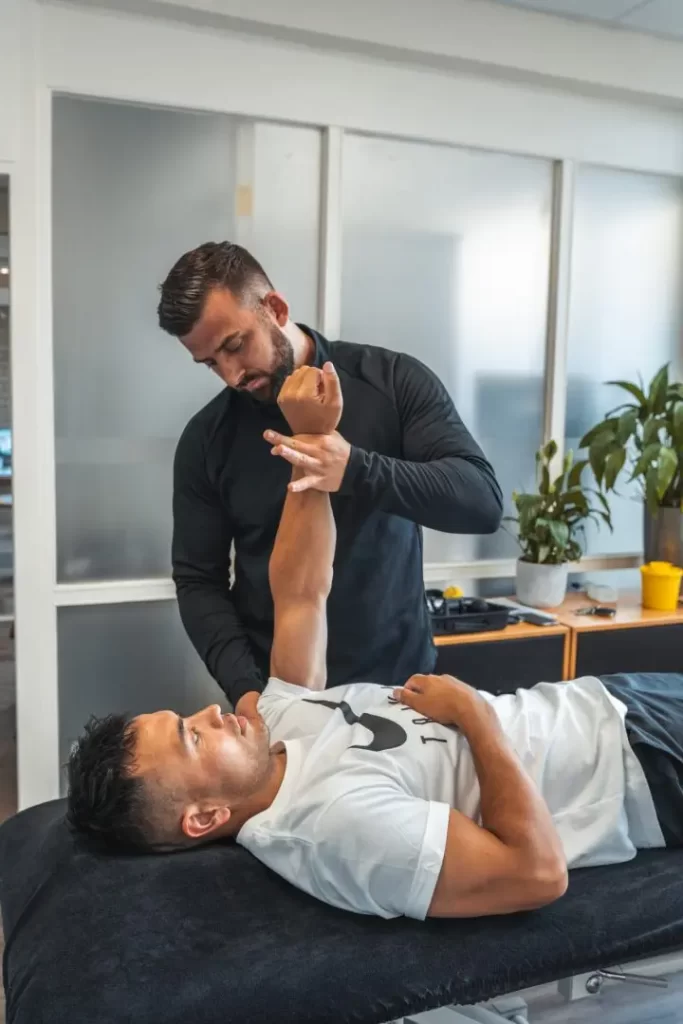Muscle injuries
Muscle ruptures, often referred to as muscle tears or in some cases as whiplash, are among the most common acute sports injuries. They occur due to a sudden and powerful stress, where the muscle fibres cannot withstand the tension and tear (partially). Think football, rugby or athletics. This can be different from a slight strain to a complete rupture with hefty consequences.
Over the years, different systems have been developed to categorise muscle injuries. The traditional three-degree system offered a simple, useful classification of muscle injury for a long time. But advances in imaging techniques such as MRI and ultrasound, muscle injuries have been shown to be much more complex than originally thought. This has led to the development of newer comprehensive systems that allow a more detailed and valuable assessment of muscle injuries. Especially with a view to returning to sport safely.

Cause
A muscle injury occurs when a muscle comes under too much tension and the pulling force of the muscle fibres is too great. This often happens during explosive movements such as sprinting, jumping or sudden deceleration, where the muscle has to contract suddenly and forcefully or is stretched under high tension. The combination of force and stretch can cause damage in the muscle fibres or even lead to a complete tear.
One of the main causes of muscle tears is excessive eccentric load. This involves a muscle delivering force while simultaneously lengthening, such as when braking a movement or catching a jump. Because eccentric contractions generate higher forces than concentric contractions, muscles are especially vulnerable to injury during this phase.
In addition, muscle ruptures can occur due to a explosive contraction under high tension. When a muscle must suddenly and maximally tighten, such as during a sprint start or a powerful kick against a ball, high internal tension is created in the muscle fibres.
Another common injury mechanism is the combination of stretching and contraction. This occurs when a muscle is activated and stretched at the same time, which often happens with bi-articular muscles. These are muscles that cross two joints and therefore have to accommodate multiple forces of movement at the same time. Examples include the hamstrings, the gastrocnemius in the calf and the rectus femoris in the quadriceps. Because these muscles experience tension from both joints, they are more prone to injury. For example, when the hamstrings have to bend the knee while the hip is stretched during sprinting, they experience double strain, increasing the risk of injury under high stress.
Common Muscle injuries

Trochanteric major pain syndrome
The trochanter major is a protruding piece of bone on the outside of the thigh

MTSS syndrome
Medial tibial syndrome (MTSS) is an injury that causes pain on the inside of...
Risk factors
- Previous muscle injuries → increased risk due to scar tissue and reduced elasticity.
- Muscle fatigue → reduced shock absorption and slower reaction time.
- Poor neuromuscular control→ delayed or incorrect activation of muscles.
- Insufficient warm-up → muscles are less prepared for strain.
- External factors → difficult surface or adverse weather conditions.
"The risk of a new muscle rupture is significantly higher when a muscle has been previously injured"
Gradations of muscle injuries
This traditional classification provides a general guideline for assessing muscle injuries, but does not take into account the exact location or specific nature of the injury. With advances in medical imaging techniques, such as MRI and ultrasound, more modern classification systems have been developed that provide a more detailed understanding of muscle injuries.
British Athletics Muscle Injury Classification
This system introduces a five-degree classification, with additional specifications on the location and nature of the injury:
- Grade 0: No structural damage visible, but patient experiences symptoms.
- Grade 1: Minor damage without significant fibre tearing.
- Grade 2: Moderate damage with obvious damage to muscle fibres.
- Grade 3: Major damage with extensive fibre tearing.
- Grade 4: Complete rupture of the muscle or muscle-tendon transition.
Each grade is further specified with a suffix ('a', 'b' or 'c') to indicate the location of the damage:
- 'a': Myofascial injury (involvement of the muscle fascia).
- 'b': Musculo-tendinous injury (involvement of the transition between muscle and tendon).
- 'c': Intratendinous injury (involvement of the tendon itself).
This classification provides a more accurate picture of the injury, which helps predict recovery time and determine the most effective treatment strategy. This is important because a tear that extends into the tendon often causes a slower recovery and higher recurrence rate compared to a superficial tear in the myofascial area.
Different types of muscle injuries
Muscle injuries are common with explosive movements and abrupt loading. Especially bi-articular muscles, such as the hamstrings, rectus femoris and gastrocnemius, are at increased risk because they walk across two joints and have to absorb multiple forces at once.
The hamstrings (biceps femoris, semitendinosus and semimembranosus) are vulnerable during sprinting and sudden acceleration. Injuries often occur due to a eccentric contraction, in which the muscle is elongated while delivering force. Symptoms include sudden sharp pain, swelling and loss of strength on knee flexion. Rehabilitation focuses on progressive eccentric training, such as Nordic hamstring curls, to avoid repetition.
The rectus femoris, the only bi-articular muscle of the quadriceps and is often injured during vigorous kicking movements or during a sprint. There is often a recognisable pain at the front of the thigh and limitation in strength.
The gastrocnemius in the calf is prone to muscle rupture, especially in the medial head, during explosive push-off or sudden ankle flexion, leading to the well-known 'whiplash'. Symptoms include sharp pain, swelling and difficulty with toe position.
The adductors in the groin and deep calf muscle soleus are more common. Groin injuries occur during rapid lateral movements and lead to pain and limited mobility, while the soleus is often overloaded during prolonged running and causes a more deep calf pain.
It is not so much the extent but the location of the damage that determines
Muscle tears can occur at different levels, ranging from mild to severe, depending on the location of the damage. Myofascial injuries are located in the muscle belly and surrounding connective tissue (fascia). These are often superficial and lead to localised pain and muscle tension without major loss of strength. Intramuscular injuries arise deeper in the muscle fibres and cause sharper pain and movement restrictions, but the tendon remains intact. Myotendinous injuries occur in the transition between muscle and tendon, a vulnerable area where forces are transferred. This type of tear often occurs during explosive movements and leads to significant loss of strength and function. Tendinous injuries involve the tendon itself and are most severe due to restricted blood flow, making recovery difficult.
A particular structure within muscles is the aponeurosis, or central tendon, which serves as internal reinforcement and plays an important role in force distribution. Injuries to the aponeurosis can be long-lasting and often affect the entire muscle function. The location of the damage - in muscle tissue, tendon or transitional areas - largely determines the severity of the injury and the complexity of the recovery process.
Making an appointment at FysioFitaal
We work from multiple locations in Tilburg, always close by for professional and accessible physiotherapy. Fill in the contact form and we will contact you soon. Together, we will work on your recovery!

